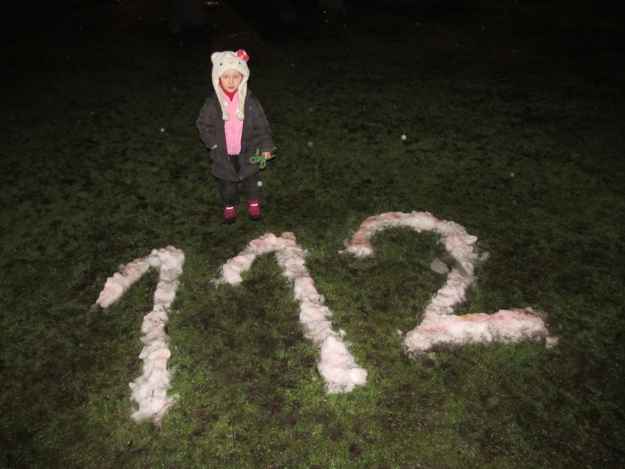
…the emergency telephone number you know as 911 is häda/abi/number 112. How are children in laste/aed (kindergarten) taught to remember this important number? They make it out of packing snow and paint it red. Photo: Riina Kindlam
There’s an expression in Estonian, that if you want someone to really understand and remember something clearly you make it “puust ja punaselt / punaseks” – in other words, carve it out of wood and paint it red, so you won’t forget.
11. veebruar is 112 day in Europe and children all over Eesti are urged to make a memorably large version of the number in their schoolyard and talk about how to make the call in an emergency.
If there’s snow, they make it out of snow, if not, they line up some pinecones or sticks. Due to a mild winter and speedy return to pluss/kraadid (above-zero temperatures) this number sculpted out of snow in a Tallinn laste/aed (kindergarten) survived one night and although it was painted red, its colour was also quick to fade.
But it was memorable nonetheless.
By calling the häda/abi or emergency number 112 free of charge, you reach the häire/keskus, the “alarm” or emergency response center, where an operator will relay your situation and location to the politsei, tule/tõrje (the fire department) or kiir/abi (ambulance); whichever päästjad (rescuers) are required.
The other geniaalne (ingenious) way of searing this number into kids’ memory banks is by using your face as a spikker (cheat sheet).
The 4-year old in the photo and her kindergarten rühma/kaaslased (group mates) were taught to point to their suu (mouth) = ÜKS, nina (nose) = ÜKS and silmad (eyes) = KAKS to recall the number 112 – a pretty good way to remember.
Other topics covered on 112 päev were what to say to the häirekeskus operator, what to do until help arrives and turvalisus (safety) in general. Even though it has been in use for 20 years now, in Estonia as well as throughout Europe, a recent Eurobarometer survey showed that Europeans are not as well informed about the number as they should be.
112 Day was created to raise awareness all over Europe.
One current major project of the Estonian sise/ministeerium (Ministry of the Interior) and emergency response centers is the implementation of the GIS-112 digital mapping application, which provides päästjad (rescuers) with the precise location of the person needing help, thereby dramatically reducing the amount of time needed to reach them.
Riina Kindlam,
Tallinn
















